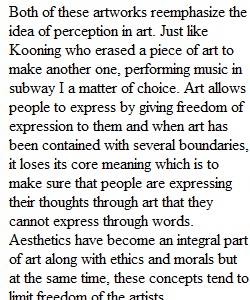


Q Anthony concluded this video talking about the importance of the FRAME in how works of art are presented. How does this work in music? Please watch the video below of Joshua Bell in the subway, and think about how much we are affected by where we see music, the name of the musician we are listening to, and the amount of money we spend on tickets. In other words, how much of our perception of a musical work is influenced by extra-musical factors? Even if you are listening to a recording in your living room with headphones on, what are the factors impinging on your understanding of the work? All of this raises a rather big philosophical question: Is there any situation in which a work of music or art can be said to exist in a kind of "pure" or most proper or most characteristic or definitive state? And once again, can you find a common thread of link between the reality of Joshua Bell playing in the subway and Rauschenberg's Erased De Kooning? Share your thoughts. Your post should be two to three (well-developed) paragraphs long. Read your classmates' posts and reply to at least one of them.
View Related Questions